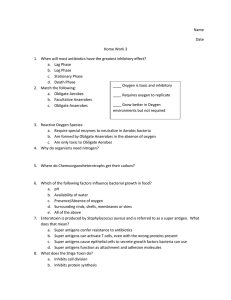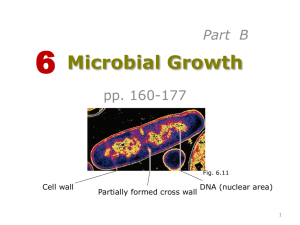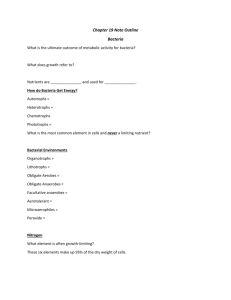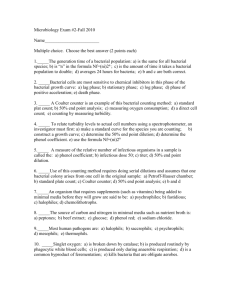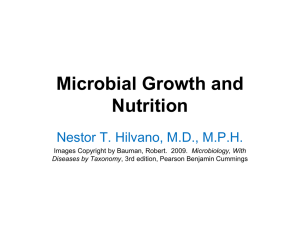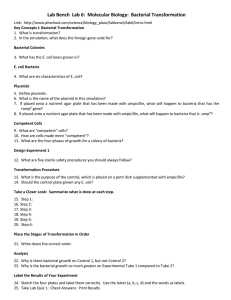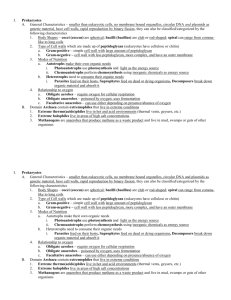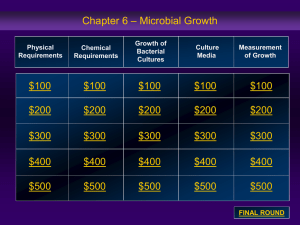Power Point
advertisement
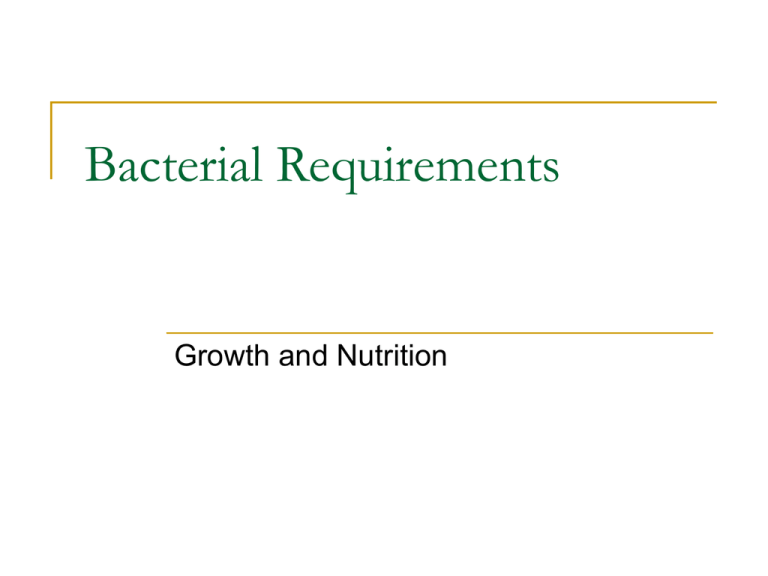
Bacterial Requirements Growth and Nutrition Bacterial Reproduction Reproduction Function Binary Fission Budding Fragmenting Increase number of cells Genetic recombination possible End result : Growth Binary Fission Budding versus Fission Fragmenting Generation Time Define Time Reason Requirements Physical Chemical Result Genetic recombination Mutations Growth Curve Graph Growth Curve Labeled Phases Lag phase Log phase Generation time doubles Most metabolically active Stationary phase Adaptive Start metabolism 1-3 days Growth = death Death phase Requirements decrease Possible spore formation Growth Curve Changes due to Ab Measurement of Microbial Growth CFU Direct Viable Plate Counts Serial Dilutions Pour Plate Spread Plate Membrane Filtration Counting Chamber MPN (fecal, H20, food) Indirect Turbidity Metabolic activity Nutritional Requirements Macro and Trace Elements Nutritional Element Use Carbon Oxygen Nitrogen Hydrogen Phosphorus Sulfur Main component Cell water, aerobic respiration AA, NA, coenzymes H20 Nucleotides, PL, LPS Several AA; coenzyme Cycles Metal Ions and Trace Minerals Potassium Magnesium Calcium Iron Cobolt Zinc Copper Manganese Cofactors in enzymatic reactions in the cell Growth Factors: Vitamins involved in many Folic Acid Biotin Niacin Pantothenic acid Riboflavin [B2] Thiamine [B1] Pyridoxine [B6] B12 K Metabolic Reactions redox deamination decarboxylation transamination synthesis Nutrient Uptake Diffusion Active Transport Simple (passive) Facilitated Osmosis ATP H+ (protomotive) Group Translocation Alter molecule PTS (phosphorylate) Group Translocation Membrane Transport Summary Oxygen Requirements Obligate Aerobes Microaerophiles Aerotolerant aerobes Obligate Anaerobes Facultative Anaerobes Capnophiles Bacterial Examples of O2 Groups Obligate Aerobes Microaerophiles E coli Clostridium Facultative Anaerobes Streptococcus Lactobacillus Obligate Anaerobes H. pylori Aerotolerant aerobes Pseudomonas E. coli Stapylococcus Capnophilic Campylobacter Staph Oxygen Requirement Classification Aerobic / Anaerobic Lab Tests aerobe FA aerotolerant anaerobe Oxygen Forms Normal Toxic Singlet: 1-O2 with electrons in higher energy state Superoxide radical: O2Peroxide Anion: O2= Hydroxide radical: OHfrom incomplete reduction of hydrogen peroxide [H2O2] Radiation EM radiation spectrum Source Sun Ionizing Radiation Visible light UV Infrared Radio waves X rays Gamma rays Create ROS Enzyme Presence to Detoxify O2 Superoxide Abligate Aerobes and FA Aerotolerant Anaerobes Obligate anaerobes SOD + + - Catalase Peroxidase + - + - Catalase Test Physical Requirements: pH Define pH mathematically Know number range pH Groups Acidophile Neutrophile Bacillus acidocaldarius Lactobacillus acidophilus E. coli Staphylococcus aureus Akaliphile Streptococcus pneumoniae Nitrobacter sp. Physical Requirements: Temperature Psychrophile Psychrotroph (facultative psychrophiles) Refrigeration Room temperature Mesophile Unsaturated FA in cell membrane Cold temperatures Warm Blooded Animals Thermophile/Hyper Saturated FA in cell membrane Psychrotrophs and Mesophiles Bacterial Examples: Temperature psychrophile mold psychrotroph Vibrio mesophile E coli thermophile Archaea Physical Requirements: Salt Extreme Halophile : 30 % NaCl Obligate Halophile : 15% NaCl Facultative Halophile : 2% NaCl Halotolerant : NaCl not needed, can grow in low salt Extreme Halophiles Great Salt Lake Osmosis and Water Activity Activity of water [Aw] = 1.0 for pure water Aw for human blood = 0.99 Range required 0.7-1.0 Aw E.coli requires Aw of 0.91 Stapylococcus requires Aw of 0.85 Physical Effect of Water Define osmosis Osmotic Pressure Tonicity Isotonic Hypertonic Hypotonic Effects Osmotolerant Hydrostatic Pressure Barotolerant Barophiles (deep ocean) Nutritional Groups Photoautotrophs Chemoautotrophs Photoheterotrophs Chemoheterotrophs Many bacteria Most all Eukarya How Acquire Electrons Organotrophs Lithotrophs Symbiotic Relationships Close ecological relationship between individuals of two or more different species Mutualism Commensalism Synergism Parasitism Competition Neutralism Biofilms Mutualism: Both Benefit Human Eye-lash mite Bacterial Symbiosis Biofilms Slime layer Fimbria Parasitism Agar Culturing Organisms Inoculum Medium Pure Culture Sterile Cultivation Media Chemically Defined Complex Undefined General Purpose Enriched Selective Differential Anaerobic Cultural Characteristics Solid Media [Petri] Color Size Shape Elevation Margin Broth Media Slant Gelatin Liquefaction Colony Characteristics on Agar Plate Complex General Media: Nutrient (TSA) Agar agar broth slant Enriched Media BAP Chocolate agar Selective and Differential Media C-CNA MSA MAC EMB Special Media MH-T SS SAB Snyder Deep Anaerobic Culture Methods Isolation Techniques Biochemical Reactions Questions?
